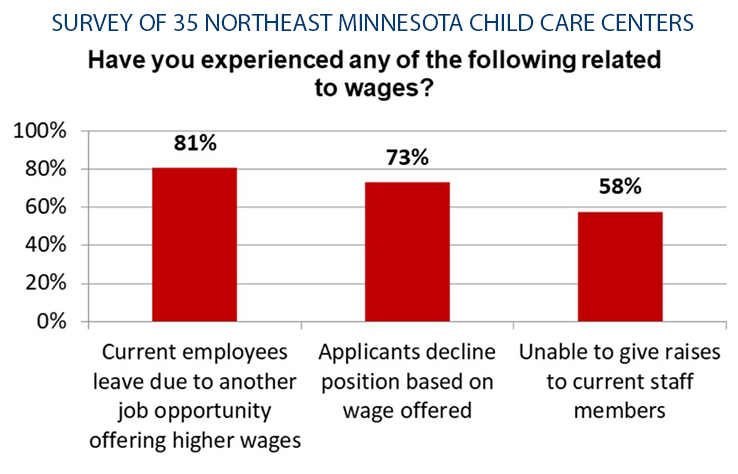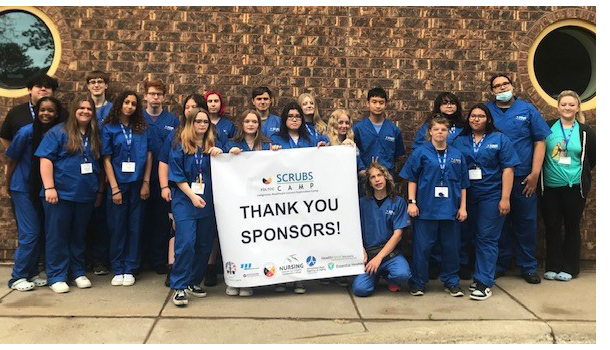
Workforce strategies amid all-time low unemployment
Attraction and retention projects and partnerships aim to bolster child care and aging services
August headlines read, “Minnesota Unemployment Rate Holds at 1.8%, an All-Time Low”. That’s good news, right? Well, yes and no. Historically low unemployment means workers have more choices but also that there is fierce competition for job seekers. Meanwhile, the costs of living and doing business are rising, putting the squeeze on both households and employers.
Two critically important “caring professions” struggling under current conditions – child care and elder care – are costly to provide compared to what most families can afford to pay. Caring for our youngest and oldest community members are two sectors that were already struggling to attract and retain workers even before the pandemic and the current tight labor market.
The Northland Foundation along with many partners is doing our part to find short- and longer-term solutions.
Child Care Workforce Survey, Working Group & Pilot Project
The child care crisis was well-known in Minnesota even before COVID-19, but the pandemic created a massive strain on providers who battled with inconsistent attendance, closures due to COVID exposure, supply shortages and high costs, and staff burnout. Now the competition for workforce is putting added stress on this sector.
Data compiled by First Children’s Finance (July 2021) shows northeast Minnesota needs 4,567 more child care openings to accommodate families with children age six and under—or 57% more spaces than we currently have.
CHILD CARE CENTER DIRECTOR SURVEY
In June, the Northland Foundation partnered with Northspan to conduct a survey of licensed child care center owners and directors in the region.
Most (72%) of those who took the survey have a child care center in St. Louis County and included both for-profit and nonprofit operations. On average, respondents indicated they could operate at full capacity with a staff of 16. Many indicated they currently have two to five positions unfilled, including teachers, assistant teachers, and substitutes.

- Pay rates and retention rose to the top of the list of current difficulties. Just over one-third reported serving fewer children due to staffing shortages. A number of owners/directors are filling in for teachers and assistants to meet adult-to-child ratios, leaving little time for administrative tasks.
- Asked to identify barriers related to staff professional development, 64% reported their biggest hurdle was coverage in the classroom while staff attend trainings.
- A major challenge within the child care industry revolves around providing teachers and other staff a competitive wage, while keeping the program operable and affordable for parents. Nearly 80% reported losing staff to other jobs with higher wages. Mental health and burnout were also cited.
“The current business model of child care does not seem to be working. In order for us to pay our employees more, we have to raise our rates and parents are already struggling. We need funding to help us maintain our workforce and be a desirable employer.”
Licensed Child Care Center Director – Survey Respondent
CHILD CARE TALENT PIPELINE WORK GROUP AND PILOT PROJECT
A Child Care Talent Pipeline Workgroup has formed and is tasked with pursuing strategies to help child care providers find and keep qualified talent. The group is facilitated by Northspan in partnership with Northland Foundation and counts center directors, higher education, economic development and business interests, and community organizations among its members.
In addition, the Northland Foundation is designing a Child Care Center Workforce Solution Pilot Project to launch this fall. The plan is to make flexible funding available to licensed child care centers to help with staff recruitment and retention to stabilize and grow program capacity. Participating pilot programs could receive additional supports and resources by attending specialized trainings and/or or peer learning opportunities.
“With the roll out of the new Child Care Talent Pipeline Work Group coupled with new Minnesota Department of Human Services Child Care Capacity Building efforts, the timing is excellent to pilot and test locally designed solutions to address workforce challenges impacting our region’s child care sector,” stated Zane Bail, Northland Foundation’s chief operating officer.
Aging Services Workforce Projects In Progress
Through our Integrated Rural Community Aging Program, a three-year initiative that will conclude at the end of 2022, the Northland Foundation has provided funding support for two regional workforce solution pilot projects. In spite of challenges and delays created by COVID, which hit just as they were getting underway in 2020, the Foundation’s two Regional Aging Services Workforce Partners have implemented exciting projects help increase the quantity and quality of paid caregivers in northeast Minnesota.
The Arrowhead Area Agency on Aging has been making great progress on projects to expand the direct care workforce.
- Hosted SCRUBS and Health Care Career Exploration camps, including one focused on Indigenous students, one virtual, and one in Hibbing, to give high school students a supportive, hands-on introduction to these careers.
- Soft-launched a robust website for the Arrowhead Regional Consortium of Healthcare Staff as a comprehensive hub for anyone looking into these careers, who are interested in advancing their careers with additional training and certifications, and for employers looking to hire. The site (here’s an introductory video) allows numerous regional and state partners to add resources such as scholarships, loan repayment programs, training, etc. as well as workforce events at any time.
- Launching a region-wide marketing program to raise awareness of the website tools and health care and aging services careers to help inform and attract more people to the field.

The Applied Learning Institute is working to increase the direct care workforce in the region by
- Improving secondary and post-secondary curriculum to align with industry standards in the healthcare sector.
- Expanding work-based learning opportunities for high school students in local healthcare facilities.
- Leading a process to co-create a vision for a regional approach to promote widespread awareness of local healthcare training programs.
Additionally, seven northeast Minnesota Community Planning and Care Coalitions, with technical support and funding also provided through the Foundation’s Integrated Regional Community Aging Program, have been hard at work in Aitkin County, Ely Area, Itasca Area/Northern St. Louis County, Koochiching County, North Shore Area, and Two Harbors driving quality of care initiatives that have:
- Increased training for volunteers to enhance recruitment, retention, and the quality of informal care.
- Created new positions such as Care Navigators and Aging Services Coordinators to help connect older adults and their caregivers in their communities with services and supports.
- Provided mileage and stipends for in-home respite and home health workers to help with worker retention and service to some of the region’s more isolated, rural areas.
- Expanded in-home visitor programs that are “eyes in the home” to ensure that older adults are receiving care and attention they need.
“Northland and our partners are doing what we can to support workforce attraction and retention in two areas where we have experience, funding, and traction: child care and aging services.”
Tony Sertich, Northland Foundation President
The Northland Foundation will continue seeking funding, collaborating with public, private and nonprofit sector partners, and testing new approaches to help ensure our youngest and oldest citizens can receive the care they need.